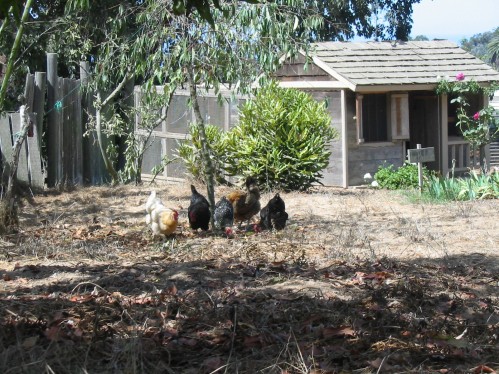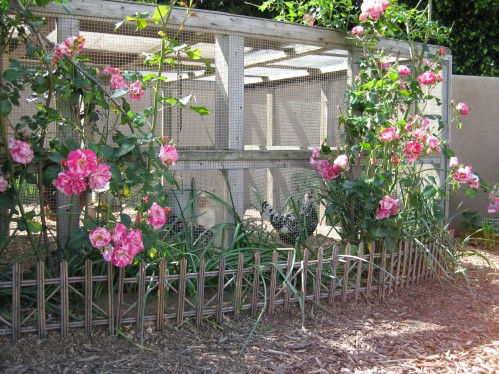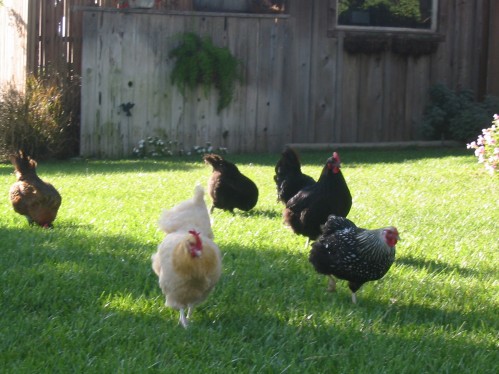 When we bought our property in the late '90's, it was sadly run down, but with a few treasures such as an old child's playhouse close to our garage. Once we were acclimated, we turned our attention to the potential of gardens, shaped trees, and desirable landscape. Soon after that we dragged the extremely heavy child's playhouse, long abandoned, down to a quiet southwest corner of our property. We saw the potential for modifying this "cutie pie" house into a perfect country coop for our soon-to-be-arriving hens.
When we bought our property in the late '90's, it was sadly run down, but with a few treasures such as an old child's playhouse close to our garage. Once we were acclimated, we turned our attention to the potential of gardens, shaped trees, and desirable landscape. Soon after that we dragged the extremely heavy child's playhouse, long abandoned, down to a quiet southwest corner of our property. We saw the potential for modifying this "cutie pie" house into a perfect country coop for our soon-to-be-arriving hens.
We first set out to secure our chicken coop in its new location. Following that, we throughly cleaned it, removed any sharp points, rain proofed it, and repaired wood boards. We next modified the windows with a strong secure wire screen, so no varmits could make their way through a window, and then created shutters to close and secure the chickens in at night. Doors, windows, and shutters should open from the outside, so as not to take up valuable space inside your chicken coop. We made a front door that opened and closed, and made a backdoor which opened and closed to the adjoining enclosed outside pen. A clever addition was a smaller door, within the back door which could be used for winter time or at times when weather is extreme. We painted the trim of the chicken coop and its front porch, and made hen nesting boxes on one side of the coop, and mounted a night roosting bar on the opposite side. Our front door and outside back door had locking capabilities.
If you have an existing building on your property or in your yard, it might be worthy of repurposing for chickens. Chickens are very forgiving, and I have heard of all sorts of housing or "recooping" from using abandoned cars, to run down avairies, to abandoned storage sheds. As I mentioned before, there are basics to keeping chickens, and the easier to clean a chicken coop, the easier it is going to be on you and your hens. It is key that you provide good ventilation without a draft for your hens. It is also important that your chicken coop be dry, and not damp and humid. Chickens respond well to sunlight for egg-laying and overall health so position your coop and outside pen accordingly, but don't forget to provide some shade too, either with a shade cloth or landscaping.
Chickens do best with feed and fresh water at all times. I hang a source of water in the outside pen, and a provide a smaller source of water inside the chicken coop floor, placed on two bricks. The feed bucket I take out to the adjoining outside pen in the morning, and return it in the evening inside the chicken coop, unless it is going to rain or storm. Please note, keep feed dry at all times. Wet feed can become moldy, rancid, and attract bugs. Chickens should not be feed wet or moldy feed. Feed stores have feeders and waters for reasonable prices. Hanging the feeders and waters is a good idea, and keeps the feed and water clean and prevents spillage. Feeders and waters should be hung by a chain at about the height of a hen's back.
Here in Southern California, temperatures rarely drop to freezing. Therefore we don't need to heat our chicken coop. Also, with the chicken coop closed up tightly at night, the hen's bodies huddled together at night on their roosting bar, also helps to keep them warm. In other parts of the country, you might have to provide heat in your chicken coop, and that would also be a factor where you locate your chicken coop.
Hens naturally need 8 hours of daylight to lay continuously. When daylight decreases, hens slowly stop laying, drop their feathers, and take a break from egg-laying, called molting. This process can take several weeks, do not be alarmed. Eventually, hens grow in beautiful new feathers, and begin to start laying eggs again. If you wish to have eggs year round from your flock, you must provide a light source to supplement the daylight length, such as a 40 watt bulb above their feeding and watering area. I prefer to let my hens follow their natural cycle, and not supplement with additional light as the day length decreases. If you require light, this too would be a factor in where you locate your chicken coop for electricity.
The size of your flock is going to be determined by your available square footage for your chicken coop, and hopefully adjoining outside pen. You cannot determine you want 12 hens, when you have proper square footage for only 5 hens. Hens will naturally form a "pecking order", and with over crowding it can lead to cannibalism, broken eggs, disease, etc.
There are a lot of points to consider when creating your chicken coop, but most of it is common sense and good management.
 Announcing VintageGardenGal's premier "Chicken Coop Photo Contest." I hear from some many of you around the world regarding your chickens and coops, I'd like to see them! Spring has got to be the best time of year to show off your chicken coop, so I thought it would be fun to have a photo contest.
Announcing VintageGardenGal's premier "Chicken Coop Photo Contest." I hear from some many of you around the world regarding your chickens and coops, I'd like to see them! Spring has got to be the best time of year to show off your chicken coop, so I thought it would be fun to have a photo contest.
 When we bought our property in the late '90's, it was sadly run down, but with a few treasures such as an old child's playhouse close to our garage. Once we were acclimated, we turned our attention to the potential of gardens, shaped trees, and desirable landscape. Soon after that we dragged the extremely heavy child's playhouse, long abandoned, down to a quiet southwest corner of our property. We saw the potential for modifying this "cutie pie" house into a perfect country coop for our soon-to-be-arriving hens.
When we bought our property in the late '90's, it was sadly run down, but with a few treasures such as an old child's playhouse close to our garage. Once we were acclimated, we turned our attention to the potential of gardens, shaped trees, and desirable landscape. Soon after that we dragged the extremely heavy child's playhouse, long abandoned, down to a quiet southwest corner of our property. We saw the potential for modifying this "cutie pie" house into a perfect country coop for our soon-to-be-arriving hens. Since I started writing about our chickens, there has been a lot of interest and questions on how to care for them. What are the components of a good chicken coop, and what kind of environment provided makes for healthy, happy, chickens. I think that many potential backyard enthusiasts would like to have chickens, but don't know what all is necessary to provide for them. I hope that I can clarify that for you.
Since I started writing about our chickens, there has been a lot of interest and questions on how to care for them. What are the components of a good chicken coop, and what kind of environment provided makes for healthy, happy, chickens. I think that many potential backyard enthusiasts would like to have chickens, but don't know what all is necessary to provide for them. I hope that I can clarify that for you.